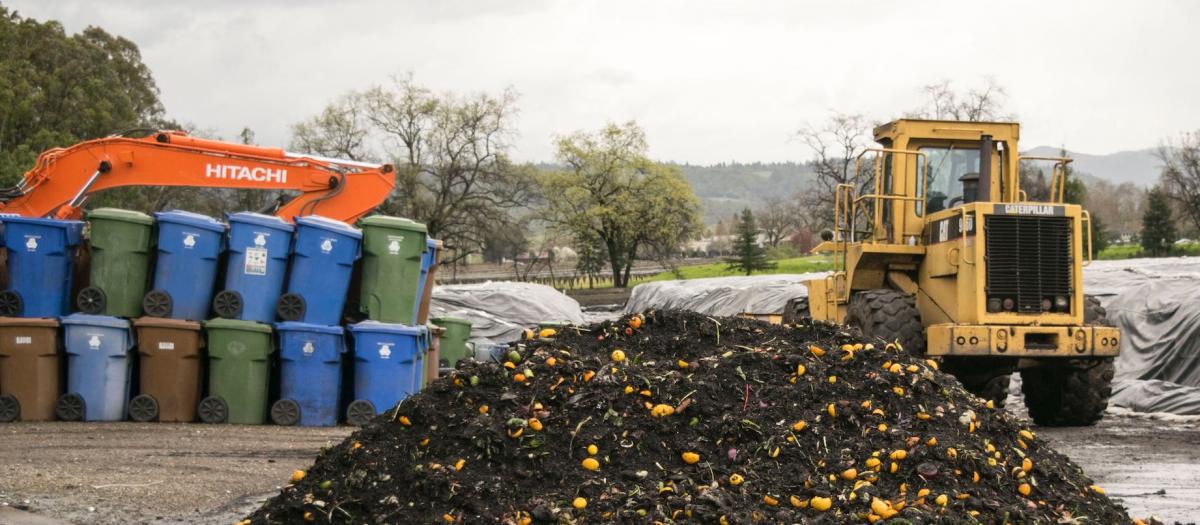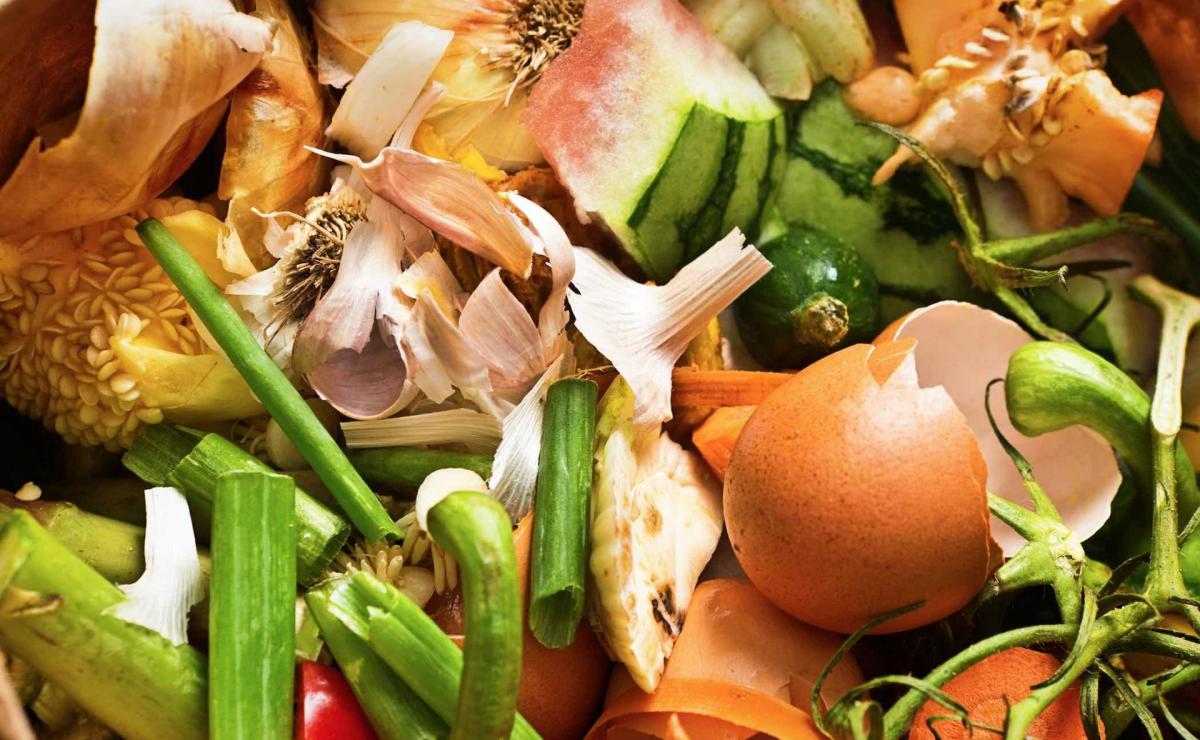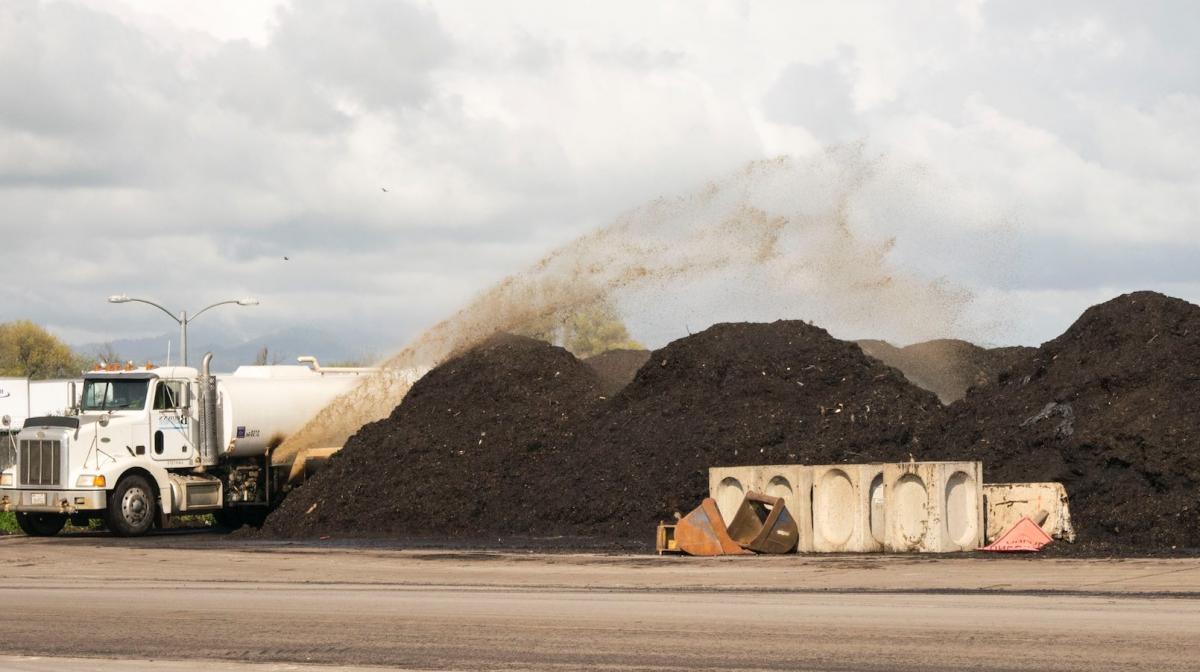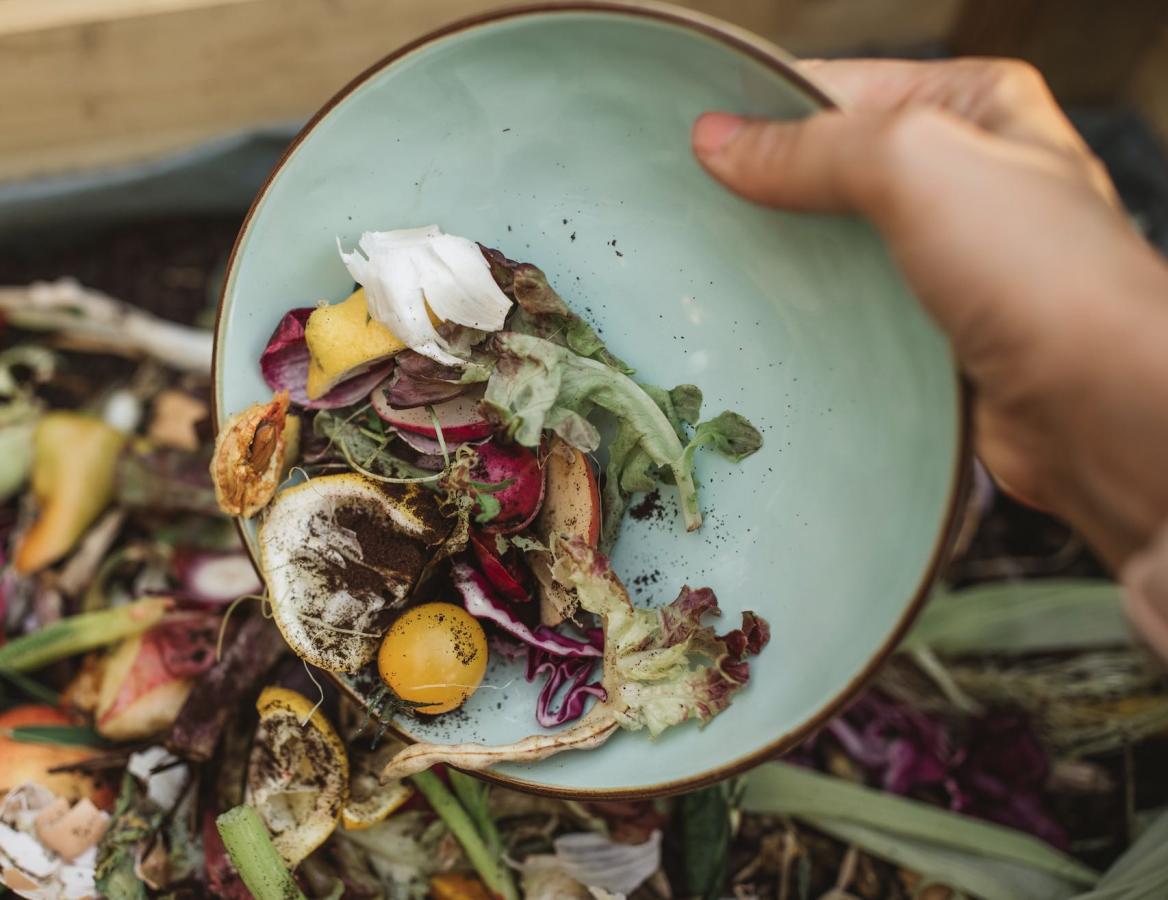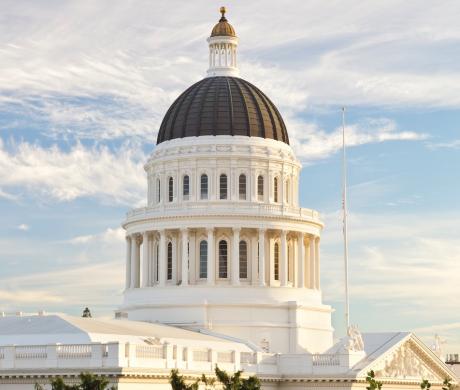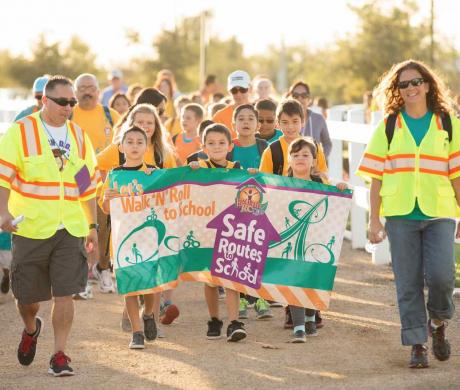What Cities Need to Know About SB 1383 and Funding Organic Waste Management
Maria West is deputy director of public affairs for the California Department of Resources Recycling and Recovery (CalRecycle) and serves as the department’s communications director. She can be reached at Maria.West@calrecycle.ca.gov.
Cities throughout California are working in partnership with the state to reduce greenhouse gas emissions, build sustainable communities, increase resiliency and fight climate change.
Now the state is tackling organic waste, a significant source of methane emissions. The California Department of Resources Recycling and Recovery (CalRecycle) is working with businesses and local jurisdictions to remove up to 26 million tons of organic material from landfills annually by 2025. This dynamic change in organic waste disposal will reduce greenhouse gas emissions, help create thousands of new jobs and improve the health of the state’s population.
Why is organic waste disposal important?
- When food and other organic material decompose, it gives off methane, a greenhouse gas over 70 times more potent than carbon dioxide during a 20-year span;
- Methane and other pollutants contribute to public health problems including heart disease and asthma, especially in the state’s most at-risk communities; and
- Landfills are currently responsible for at least 21 percent of the state’s methane emissions.
Achieving Climate Goals Through Recycling and Recovery
In September 2016, Gov. Jerry Brown signed SB 1383 (Chapter 395, Statutes of 2016), which requires organic waste in California landfills to be reduced 50 percent from 2014 levels by 2020 and 75 percent by 2025. It also requires that by 2025 at least 20 percent of edible food currently sent to landfills be recovered for human consumption. The law directs CalRecycle to adopt regulations designed to achieve these targets, reduce methane emissions and support the state’s climate change goals.
To achieve these targets, it’s essential for all organic waste generators — residences, businesses and local, state and federal government entities — to actively participate in organic material collection and food recovery programs. Jurisdictions must adopt enforceable ordinances to ensure that all residential and commercial generators are compliant. Penalties for noncompliance can be assessed by CalRecycle beginning in 2022 — and by local jurisdictions beginning in 2024.
Local Communities Help Develop Program Requirements
For the past three years, CalRecycle has worked with local communities throughout the state to create regulations. Cities and counties subsequently developed implementation requirements for both organic waste collection services and food recovery programs, which take into account unique regional needs and the need for local flexibility. As a result of community feedback, CalRecycle incorporated changes into the regulations that have reduced estimated administrative costs to local jurisdictions by 50 percent.
Key Elements: Planning and Implementation
Cities that have not started preparing for SB 1383 compliance should immediately begin planning for and implementing the required organic waste collection and edible food recovery services. This work includes assessing and securing adequate capacity for organics processing and edible food recovery, which can be done individually or in conjunction with counties, other cities and regional agencies.
Local governments will most likely need to increase rates and amend their agreements with collection service providers to support SB 1383 compliance. Implementation costs for local jurisdictions will include:
- Outreach and education;
- Collection services;
- Enforcement; and
- Organic waste infrastructure and processing costs.
To assist local jurisdictions, CalRecycle is developing model franchise agreements, enforcement ordinances, procurement policies and model food recovery agreements for local use. These will be available in March 2020.
Funding Is Available for Infrastructure
Due to the passage of the state’s Mandatory Commercial Organics Recycling law in 2014, most California jurisdictions already offer some type of organics collection service. However, CalRecycle estimates the state will need 50 to 100 new or expanded composting and anaerobic digestion facilities to process and recover at least 26 million tons of organic waste annually by 2025.
Several funding sources are available for jurisdictions to increase organics recycling and edible food recovery infrastructure. To date, California has funded more than $85 million for new organic waste recycling and edible food recovery infrastructure through cap-and-trade grants. Additional cap-and-trade funding will be available in 2020.
Available funding sources for infrastructure include:
- CalRecycle’s Organics Grant Program
- California Energy Commission grants
- California Air Resources Board grants
- Business Energy Investment Tax Credit
- Low-Carbon Fuel Standard
- California Pollution Control Financing Authority (CPCFA) tax-exempt bonds
- Recycling Market Development Zone (RMDZ) Loans and Greenhouse Gas Reduction Loans
The CalRecycle website provides additional financial resources and economic incentives at www.calrecycle.ca.gov/business/incentives.
Implementation Costs and Estimated Cost Increases
Implementation costs will vary by jurisdiction. Those with existing programs could see little or no rate increases. Mandatory collection will increase the customer base for organics collection, which will create economies of scale for haulers and lower per-unit costs compared with a nonmandatory system. However, SB 1383 compliance could require potentially significant rate increases in some jurisdictions. The average cost increase to households is estimated at $3 to $5 per month, while the average increase to businesses is estimated at $70 to $90 per month.
Many California cities have already developed — or are actively developing — new or updated organics recycling processing services and infrastructure. Their successes, challenges and lessons can inform other cities working to implement SB 1383 regulations.
The following examples illustrate approaches various jurisdictions have taken to increase organics collection and processing.
Education and Bin Labels Aided San Ramon’s Leap to Organics
The City of San Ramon (pop. 83,957) in Contra Costa County recently negotiated a new waste and recycling services contract that includes mandatory organic waste collection for all customers and free compost giveaways. The contract includes a 30 percent rate increase.
“No one likes a rate increase, but when we had an opportunity to speak with people about the reasons behind it, they understood,” says David Krueger, solid waste and recycling program manager for San Ramon. “Many smaller businesses located closely together are sharing organics bins, and multifamily complexes generally have one or two large organics bins on site.”
The rate increases were due not only to the cost of SB 1383 implementation, which included expanded organics collection services, new bin labels and staffing for outreach and enforcement, but also to labor rate increases and the fluctuating international commodities market, according to Krueger. In March 2019, San Ramon started conducting outreach and notifying residents of rate increases coming in January 2020.
Advance Notice and Minimal Rate Increases in Kerman
The City of Kerman (pop. 15,495) in Fresno County has long had a contract with Mid Valley Disposal, which received two California Climate Investment grants to build and later expand its composting facility. Kerman City Manager John Kunkel says Mid Valley manages much of the local outreach and education for SB 1383 implementation, including visiting schools, sending information home with students and hosting booths at carnivals and festivals.
“The outreach is critical,” says Kunkel. “If you tell people what’s coming up, then it’s not a surprise and it will go smoothly.”
Residential pickup rates went up by $1.25 per month, and the city implemented the increase in two phases over a two-year period. The first increase was 50 cents, and the second was 75 cents.
Residents received three 96-gallon bins, which are all serviced on the same day. Kunkel points out that many Kerman residents have sizable lots and welcomed the large bins for organic material. “People will recycle if you educate them and give them the apparatus to do it,” he says.
Lower Rates for Recycling and Compost Boosted Visalia’s Success
The City of Visalia (pop. 138,207) in Tulare County has had a robust organics program, including residential green waste and food scraps collection, since 2008.
Its solid waste and recycling programs comprise infrastructure, vehicles and containers and are funded by the city’s solid waste fees. Visalia builds in incentives for residents and businesses; for example, recycling services are 50 percent cheaper than garbage collection, and organics services cost 25 percent less than garbage collection.
“We reached out to folks on the commercial side to let them know that the rules are changing,” says Nathan Garza, natural resource conservation technician with Visalia’s Natural Resource Conservation Division. Because larger businesses were already recycling organics, the city is focusing on working with smaller shops and businesses on SB 1383 implementation.
Challenges include space constraints in downtown commercial areas that limit the introduction of recycling and organics bins, so some businesses share bins. The city switched from “split-can” recycling bins, which had been in use since the 1980s and needed replacing, to three 90-gallon bins for garbage, recycling and organics. Visalia has sent its organic material to two nearby composting facilities for years, so the city did not need to find new markets, and no rate increases are planned.
Infrastructure Development in San Luis Obispo County
Southwest of Visalia, the City of San Luis Obispo (pop. 280,393) and five other municipalities in the county share an exclusive contract with Waste Connections for residential and commercial garbage, organics and recycling collection.
Hitachi Zosen Corporation built and operates an anaerobic digestion facility on land leased from Waste Connections, which provides feedstock to the facility under a 20-year agreement. The facility went online at the end of 2018. It can convert 36,500 tons of food waste and urban green waste per year into 6.8 million kilowatt-hours of electricity, 13,000 tons of compost and 1.6 million gallons of liquid fertilizer.
The $25 million facility received $4 million from the California Energy Commission and another $4 million in cap-and-trade funding from CalRecycle’s Organics Grants Program. It also qualified for an investment tax credit for producing renewable energy.
Food Recovery to Help Feed the Hungry
Much of the roughly 6 million tons of food disposed in California landfills each year is edible when it enters the system. The food recovery target in SB 1383 means more food for the one in eight Californians and one in five children who are food insecure — uncertain whether they will consistently have enough to eat and be adequately nourished.
In 2019, California awarded $11 million for 36 local edible food waste prevention and rescue projects through its continuing Food Waste Prevention and Rescue Grant Program.
Funds were used in a wide variety of eligible ways, including:
- Purchasing refrigerated delivery vans;
- Expanding cold storage capacity;
- Paying collection and delivery drivers;
- Purchasing food management software;
- Increasing education and outreach efforts; and
- Analyzing and improving food waste and prevention policies at hospitals, universities, entertainment venues and corporate dining facilities.
Financial and Social Benefits for California
The cost of recovering edible food and collecting organic waste for recycling and composting will increase waste collection rates, but it also eliminates hidden health and environmental costs associated with disposal. Organic waste recycling gives local governments a proactive solution that will bring tangible benefits to their communities.
Statewide, California communities can expect to realize collective savings and benefits that include:
- $10.4 billion in decreased landfill disposal costs;
- $10 to $13 billion in decreased hospitalizations and reduced mortality rates as a result of reduced pollution and improved air quality;
- 17,000 green recycling and remanufacturing jobs created in local communities;
- $17.7 billion in revenue generated from new organics recycling facilities; and
- Improved soil health and drought and climate resilience, as greenhouse gas emissions decrease and more compost is available to serve California agriculture.
Furthermore, reducing the negative health impacts of pollution and rescuing edible food for people who need it strengthens our most vulnerable communities — and our state as a whole. SB 1383 takes a bold, ambitious and necessary step to achieve the state’s climate change goals. Working together, Californians, the state, local governments, and the waste and recycling industry can achieve these goals and build a more sustainable future.
Related Resources
Scrap Your Fears About Food Waste Regulations: Preparing for SB 1383
Institute for Local Government Recycling Resource Center: www.ca-ilg.org/recycling
Institute for Local Government Sustainability Best Practices Framework: www.ca-ilg/org/sustainabilitybestpractices
Resiliency Is Key to Managing the Risks of Climate Change
SB 375 Explained by Darrell Steinberg
The Basics of SB 375, Institute for Local Government
Key Bills and Policies in California That Address Climate Change
California’s Food Waste Prevention and Rescue Grant Program awarded $11 million for 36 local edible food waste prevention and rescue projects in 2019.
CalRecycle’s website provides additional financial resources and economic incentives at www.calrecycle.ca.gov/Business/Incentives.
CalRecycle Organics Grant Program www.calrecycle.ca.gov/climate/grantsloans/organics

